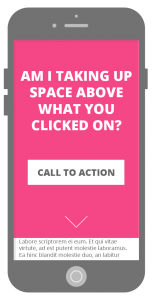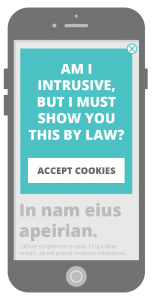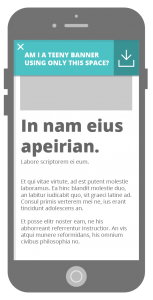On the 10th of January 2017 Google will introduce a change to the mobile search results, this news is bad news for websites that use intrusive interstitials. Those websites with intrusive interstitials blocking access to content will lose visibility in mobile search results.
The first thing to note about this change is that not all interstitials count as ‘intrusive.’ There are three types which are still allowed:
- Legal interstitials for cookies and age verification etc.
- Logins for content that isn’t publicly indexable
- Unobtrusive banners that can be easily dismissed and don’t take up too much space, such as app install banners on Safari and Chrome.
Bad interstitial examples:



Good interstitial examples:



Exit interstitials
Exit interstitials are not included in the new algorithm update either. These interstitials show once a user tries to leave a web page. However, exit interstitials won’t be a feasible option for many marketers, as they are strongly associated with spam and malware and not allowing users to leave your page doesn’t do your brand reputation much good.
The type of interstitials that are going to fall foul of the new rules are ones that cover most, or all of the content before the user can read it. Common uses for this type of interstitial are for mobile advertising, data collection and market research.
Google hasn’t announced details of the penalties it will be using, whether it will be an outright ban from the search engine for content with interstitials, or if the content will be shunted down the results page in favour of similar content without them. We will, of course, be monitoring this as the change comes in.
 The only change we know for certain is the removal of the “Mobile friendly” status on mobile websites that intrusively ask you to download their mobile app.
The only change we know for certain is the removal of the “Mobile friendly” status on mobile websites that intrusively ask you to download their mobile app.
Many websites, big and small and in all sectors, use interstitials that may fall foul of this update, such as Vice, Forbes, and The Daily Mash. Although Google hasn’t confirmed exactly how large ‘intrusive’ is, try to stick to less than 15% of the above the fold content.
What are interstitials?
Interstitials are pop-ups that block the content of the page, until they are either dismissed or another action takes place, such as signing up for a newsletter. Digital marketers were first attracted to pop-ups as a way of monetising their websites. For some time, pop-ups have been an effective method of encouraging website users to take an action and for online advertising.
Interstitials have developed and evolved to become more intrusive, as advertisers demand more exposure and website owners look to drive up conversions.
How are mobile interstitial ads used?
Interstitial ads have a wide variety of uses. They are often used as mobile advertising through systems such as Mopub. Otherwise, mobile interstitial ads can be used for data capture or market research. Although they look impressive, they are very easy to set up, with plugins such as Modal being developed for Joomla sites.
Why doesn’t Google like interstitials?
For the same reasons I don’t, you don’t and no one does. When you click through to a piece of content you want to be able to see that content, not jump through several hoops first. This is especially true for mobile as it can be more difficult to close interstitials and load time can be much slower on mobile networks.
So this is all about user experience?
Yes. Since Google first introduced the “mobile-friendly” tab on mobile search, way back in 2014, a significant amount of the mobile search algorithm has focused on user experience, rather than on the traditional optimisation signals such as site authority. This new algorithm update is designed to encourage better user experience.
Google is by far the most powerful and popular search engine, but by no means the only one. They still rely on delivering good results to searchers and if someone clicks on a description they expect to get through to that content, not an unrelated interstitial.
What you need to do now
If you are turning white and cancelling your Christmas plans while you read this, there is no need. You can adapt your interstitials, or use alternative methods to keep in Google’s good books and not damage your conversion rates.
Delve into your Analytics
Look at your bounce rates. You will probably find that Google is right about interstitials and pages with interstitials do have a higher than average bounce rate and lower quality overall traffic. What are your conversion rates like? How much is the interstitial achieving? Is it adding value to your website or turning users away.
A/B test
You have some time to play around with designs and find out how to equal or better the conversion rate you achieve from your interstitials. Try some pages with an ‘unobtrusive’ interstitial, some with CTAs in the header or sidebars and some with CTAs throughout the text. Open up a spreadsheet, reach for your calculator and find out which nudges work best for your readers.
Offer better plans to advertisers
If you make your money through selling ad space, rethink what packages you can offer them. Can you include social and your email list to entice them to advertise with you? There are often more effective marketing methods than interstitials that will provide better value for advertisers.
Use ready-made tools
If you don’t fancy spending a long time getting your interstitials to fit in with Google’s guidelines, then there are several products out there that will do it for you…
Google has given us plenty of warning for this change, even if the exact details on penalties are a little vague. Website designers, developers, and owners should always be looking to improve their user experience, so now we all have the encouragement we need to banish annoying interstitials for good and find, better user-friendly ways of running adverts, encouraging sign-ups collecting data.
Be sure to check back in January where we will cover any upcoming losses to visibility.


